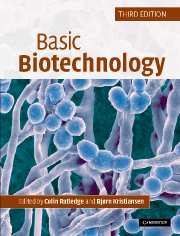Book contents
- Frontmatter
- Contents
- List of contributors
- Preface to the second edition
- Preface to the third edition
- Part I Fundamentals and principles
- Chapter 1 Public perception of biotechnology
- Chapter 2 Biochemistry and physiology of growth and metabolism
- Chapter 3 Stoichiometry and kinetics of microbial growth from a thermodynamic perspective
- Chapter 4 Genome management and analysis: prokaryotes
- Chapter 5 Genetic engineering: yeasts and filamentous fungi
- Chapter 6 Microbial process kinetics
- Chapter 7 Bioreactor design
- Chapter 8 Mass transfer
- Chapter 9 Downstream processing
- Chapter 10 Measurement, monitoring, modelling and control
- Chapter 11 Process economics
- Part II Practical applications
- Index
Chapter 5 - Genetic engineering: yeasts and filamentous fungi
Published online by Cambridge University Press: 05 June 2012
- Frontmatter
- Contents
- List of contributors
- Preface to the second edition
- Preface to the third edition
- Part I Fundamentals and principles
- Chapter 1 Public perception of biotechnology
- Chapter 2 Biochemistry and physiology of growth and metabolism
- Chapter 3 Stoichiometry and kinetics of microbial growth from a thermodynamic perspective
- Chapter 4 Genome management and analysis: prokaryotes
- Chapter 5 Genetic engineering: yeasts and filamentous fungi
- Chapter 6 Microbial process kinetics
- Chapter 7 Bioreactor design
- Chapter 8 Mass transfer
- Chapter 9 Downstream processing
- Chapter 10 Measurement, monitoring, modelling and control
- Chapter 11 Process economics
- Part II Practical applications
- Index
Summary
Glossary
Auxotrophic mutation A mutation in a gene that confers the requirement for a growth factor to be supplied rather than synthesised by the organism. A gene that complements this auxotrophic mutation is one that can return the organism to its normal phenotype (i.e. not requiring the growth factor).
cDNA Single-stranded DNA with a complementary sequence to messenger RNA (mRNA), synthesised in vitro. Double-stranded cDNA can then be made. cDNA libraries contain double-stranded cDNA molecules, each of which forms part of a vector (q.v.). The collection of cDNA molecules, each in a separate vector, forms the cDNA library.
Chaperone A protein that assists the folding of another protein.
Chromatin A highly organised complex of protein and DNA.
Chromosome A discrete unit of DNA (containing many genes) and protein. Different species have different numbers of chromosomes (see Table 5.1).
Circular DNA molecule See plasmid.
Complementation The ability of a gene to convert a mutant phenotype (q.v.) to the wild-type.
Cosmid Plasmid (q.v.) containing sequences (phage lambda cos sites) that permit packaging of the plasmid into the proteinaceous phage coat.
Cross-over See homologous recombination.
Dimorphism Ability to exist as two structurally distinct forms.
Endoplasmic reticulum (ER) Intracellular membrane structure in eukaryotes forming the early part of the protein secretory pathway.
Exons The coding regions of a gene (excluding the introns).
Expressed sequence tag (EST) A portion of a cDNA, usually of sufficient length to provide useful sequence information to enable identification or cloning of a full-length gene.
- Type
- Chapter
- Information
- Basic Biotechnology , pp. 119 - 154Publisher: Cambridge University PressPrint publication year: 2006
- 2
- Cited by

